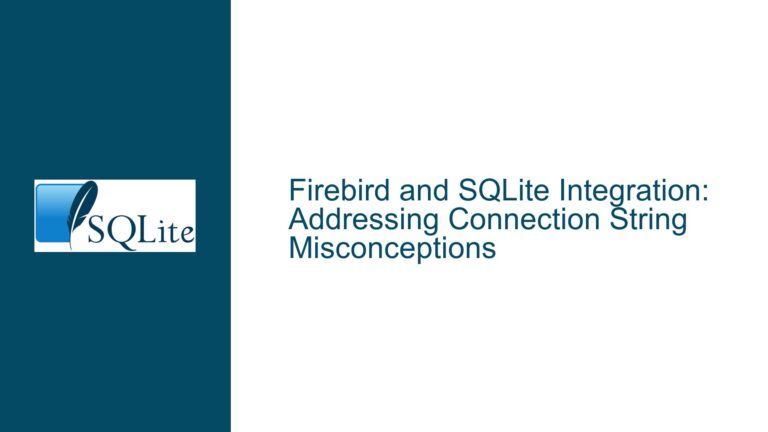Virtual Table xCommit Called Without xBegin: Causes & Fixes
Understanding Transaction Method Invocation in SQLite Virtual Tables
Transaction Lifecycle Expectations and Observed Behavior
The core issue arises when the xCommit method of a SQLite virtual table is invoked without a preceding xBegin call, contradicting the documented transaction lifecycle. In SQLite, virtual tables implementing custom transaction handling must adhere to a strict sequence: xBegin initiates a transaction, xSync ensures data persistence, and xCommit finalizes changes. The problem manifests when creating a virtual table using CREATE VIRTUAL TABLE, triggering xConnect followed directly by xCommit, bypassing xBegin.
This behavior violates the transaction method invocation contract defined in SQLite’s documentation. Virtual table implementations expecting xCommit to always follow xBegin will encounter undefined states or errors when this sequence is disrupted. The anomaly is reproducible using a minimal virtual table implementation based on templateVtab, where module registration and table creation bypass expected transaction boundaries.
Improper Transaction Method Implementation and Implicit Commit Triggers
Three primary factors contribute to this unexpected method invocation pattern:
1. Missing xBegin Method in Virtual Table Implementation
SQLite only enforces transaction method consistency at runtime if the virtual table explicitly declares transaction support by implementing xBegin. When a virtual table implements xCommit without xBegin, the engine assumes transaction handling is partially implemented but doesn’t validate call order. This creates a situation where schema changes (like CREATE VIRTUAL TABLE) that trigger implicit commits can call xCommit directly.
2. Ephemeral Transactions During DDL Operations
Data Definition Language (DDL) statements like CREATE VIRTUAL TABLE execute within automatic transactions managed by SQLite. When a virtual table’s xConnect method modifies database state (even indirectly), the engine may generate an ephemeral transaction that commits immediately after table creation. If the virtual table’s transaction methods are improperly implemented, this implicit commit triggers xCommit without going through xBegin.
3. Eponymous Virtual Table Registration Side Effects
Eponymous virtual tables (those created automatically when a module is registered) interact differently with transaction boundaries compared to explicitly created tables. The registration process itself may create temporary schema entries that undergo automatic transaction handling. If the virtual table module contains active xCommit implementations, these registration-related transactions can erroneously invoke xCommit during initialization phases that never called xBegin.
Implementing Transaction Method Guards and Explicit Lifecycle Control
Step 1: Validate Transaction Method Implementation
Review the virtual table’s sqlite3_module structure to ensure transaction methods are either fully implemented or completely omitted. The structure should either:
- Contain valid function pointers for all three transaction methods (
xBegin,xSync,xCommit) - Set all transaction method pointers to
NULLif no transaction support is needed
For minimal virtual tables without transaction requirements:
static sqlite3_module testModule = {
/* ... other methods ... */
.xBegin = 0, // Explicit null assignment
.xSync = 0,
.xCommit = 0,
/* ... remaining methods ... */
};
Step 2: Intercept Implicit Commits During DDL Execution
Modify the xConnect method to detect and handle transactions initiated by DDL operations. Since CREATE VIRTUAL TABLE automatically wraps its execution in a transaction, virtual tables can check for active transactions using sqlite3_get_autocommit():
static int testConnect(
sqlite3 *db,
void *pAux,
int argc, const char *const*argv,
sqlite3_vtab **ppVtab,
char **pzErr
){
if(sqlite3_get_autocommit(db) == 0){
// Called within explicit transaction
} else {
// Called in autocommit mode - implicit transaction
}
// ... rest of implementation ...
}
Handle implicit transactions by either:
- Deferring schema modifications until explicit transactions
- Implementing no-op transaction methods that satisfy method call order
Step 3: Implement Transaction State Tracking
Add internal state management to track transaction progression. Maintain a transaction depth counter that increments on xBegin and decrements on xCommit/xRollback. Validate method call order using this counter:
typedef struct TestVtab TestVtab;
struct TestVtab {
sqlite3_vtab base;
int transactionDepth; // Transaction state tracker
};
static int testBegin(sqlite3_vtab *pVTab){
TestVtab *p = (TestVtab*)pVTab;
p->transactionDepth++;
return SQLITE_OK;
}
static int testCommit(sqlite3_vtab *pVTab){
TestVtab *p = (TestVtab*)pVTab;
if(p->transactionDepth == 0){
return SQLITE_ERROR; // Prevent invalid commit
}
p->transactionDepth--;
return SQLITE_OK;
}
Step 4: Modify Virtual Table Registration Workflow
For eponymous virtual tables, decouple module registration from initial schema modifications. Delay any persistent storage operations until the first explicit xOpen or xFilter call. This prevents transaction method invocations during registration:
static int testConnect(
sqlite3 *db,
void *pAux,
int argc, const char *const*argv,
sqlite3_vtab **ppVtab,
char **pzErr
){
// Initialize virtual table structure WITHOUT
// writing to database schemas or storage
TestVtab *pNew = sqlite3_malloc(sizeof(*pNew));
*ppVtab = (sqlite3_vtab*)pNew;
return SQLITE_OK;
}
Step 5: Implement Transaction Method Fallbacks
For virtual tables that require partial transaction support, create safe fallbacks for missing method calls. If xBegin is never called but xCommit is invoked, either:
- Treat it as a no-op and return
SQLITE_OK - Return
SQLITE_ERRORto force proper transaction sequencing
static int testCommit(sqlite3_vtab *pVTab){
TestVtab *p = (TestVtab*)pVTab;
if(p->transactionDepth <= 0){
// Option 1: Silent no-op
return SQLITE_OK;
// Option 2: Enforce transaction order
// sqlite3_log(SQLITE_ERROR, "Invalid xCommit call");
// return SQLITE_ERROR;
}
p->transactionDepth--;
return SQLITE_OK;
}
Step 6: Utilize SQLite’s Transaction Hooks
Install database connection hooks to monitor transaction state changes. This provides global visibility into transaction boundaries affecting virtual tables:
void *testHookArg = 0;
static void testUpdateHook(
void *arg,
int op,
char const *dbName,
char const *tableName,
sqlite3_int64 rowid
){
// Monitor COMMIT operations
}
sqlite3_update_hook(db, testUpdateHook, testHookArg);
Combine this with virtual table-specific state tracking to correlate hook events with method invocations.
Step 7: Enable SQLite’s Debugging Facilities
Compile SQLite with -DSQLITE_DEBUG and use sqlite3_db_status() to gather transaction statistics:
int highwater = 0;
int current = 0;
sqlite3_db_status(db, SQLITE_DBSTATUS_STMT_USED, ¤t, &highwater, 0);
Monitor statement execution counts and transaction nesting levels during virtual table operations.
Step 8: Implement Cross-Method Invocation Validation
Add runtime checks in all transaction methods to verify call order:
static int testBegin(sqlite3_vtab *pVTab){
TestVtab *p = (TestVtab*)pVTab;
if(p->transactionDepth != 0){
return SQLITE_ERROR; // Nested transaction not supported
}
p->transactionDepth++;
return SQLITE_OK;
}
static int testSync(sqlite3_vtab *pVTab){
TestVtab *p = (TestVtab*)pVTab;
if(p->transactionDepth != 1){
return SQLITE_ERROR; // Sync without active transaction
}
return SQLITE_OK;
}
static int testCommit(sqlite3_vtab *pVTab){
TestVtab *p = (TestVtab*)pVTab;
if(p->transactionDepth != 1){
return SQLITE_ERROR;
}
p->transactionDepth--;
return SQLITE_OK;
}
Step 9: Analyze Virtual Table Usage Patterns
Audit all SQL statements interacting with the virtual table. Use EXPLAIN to view generated bytecode and identify implicit transaction boundaries:
EXPLAIN COMMIT; -- View transaction handling bytecode
EXPLAIN CREATE VIRTUAL TABLE temp.test USING test();
Look for opcodes like Transaction, Commit, or AutoCommit that indicate automatic transaction management.
Step 10: Modify Application-Level Transaction Control
Wrap virtual table DDL operations in explicit transactions to control method invocation:
BEGIN;
CREATE VIRTUAL TABLE temp.test USING test();
COMMIT; -- This should trigger xBegin/xCommit sequence
Monitor whether explicit transaction blocks correct the method call order, indicating that implicit transactions were the root cause.
Final Solution Implementation
For the specific case where xCommit is called after xConnect without xBegin during virtual table creation:
- Remove Transaction Method Implementations
If the virtual table doesn’t require custom transaction handling, nullify all transaction method pointers in thesqlite3_modulestructure:
static sqlite3_module testModule = {
/* ... */
.xBegin = 0,
.xSync = 0,
.xCommit = 0,
/* ... */
};
- Implement Optional Transaction Support
For tables needing transaction control, add full state tracking and validation:
struct TestVtab {
sqlite3_vtab base;
int txDepth; // Transaction depth counter
};
static int testBegin(sqlite3_vtab *pVTab){
struct TestVtab *p = (struct TestVtab*)pVTab;
if(p->txDepth != 0) return SQLITE_ERROR;
p->txDepth++;
return SQLITE_OK;
}
static int testCommit(sqlite3_vtab *pVTab){
struct TestVtab *p = (struct TestVtab*)pVTab;
if(p->txDepth != 1) return SQLITE_ERROR;
p->txDepth--;
return SQLITE_OK;
}
- Handle Implicit Commits Gracefully
ModifyxCommitto safely handle unexpected invocations:
static int testCommit(sqlite3_vtab *pVTab){
struct TestVtab *p = (struct TestVtab*)pVTab;
if(p->txDepth == 0){
// Log warning but return OK
sqlite3_log(SQLITE_WARNING, "xCommit called without xBegin");
return SQLITE_OK;
}
p->txDepth--;
return SQLITE_OK;
}
By systematically addressing transaction method implementation completeness, validating call sequences, and accounting for SQLite’s automatic transaction handling, developers can eliminate invalid xCommit invocations while maintaining robust virtual table functionality.






